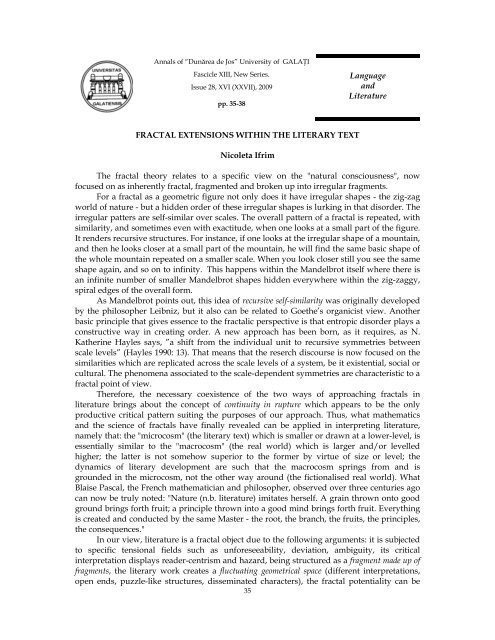You also want an ePaper? Increase the reach of your titles
YUMPU automatically turns print PDFs into web optimized ePapers that Google loves.
Annals of “Dunărea <strong>de</strong> <strong>Jos</strong>” University of GALAŢI<br />
Fascicle XIII, New Series.<br />
Issue 28, XVI (XXVII), 2009<br />
pp. 35-38<br />
FRACTAL EXTENSIONS WITHIN THE LITERARY TEXT<br />
Nicoleta Ifrim<br />
Language<br />
and<br />
Literature<br />
The fractal theory relates to a specific view on the "natural consciousness", now<br />
focused on as inherently fractal, fragmented and broken up into irregular fragments.<br />
For a fractal as a geometric figure not only does it have irregular shapes - the zig-zag<br />
world of nature - but a hid<strong>de</strong>n or<strong>de</strong>r of these irregular shapes is lurking in that disor<strong>de</strong>r. The<br />
irregular patters are self-similar over scales. The overall pattern of a fractal is repeated, with<br />
similarity, and sometimes even with exactitu<strong>de</strong>, when one looks at a small part of the figure.<br />
It ren<strong>de</strong>rs recursive structures. For instance, if one looks at the irregular shape of a mountain,<br />
and then he looks closer at a small part of the mountain, he will find the same basic shape of<br />
the whole mountain repeated on a smaller scale. When you look closer still you see the same<br />
shape again, and so on to infinity. This happens within the Man<strong>de</strong>lbrot itself where there is<br />
an infinite number of smaller Man<strong>de</strong>lbrot shapes hid<strong>de</strong>n everywhere within the zig-zaggy,<br />
spiral edges of the overall form.<br />
As Man<strong>de</strong>lbrot points out, this i<strong>de</strong>a of recursive self-similarity was originally <strong>de</strong>veloped<br />
by the philosopher Leibniz, but it also can be related to Goethe’s organicist view. Another<br />
basic principle that gives essence to the fractalic perspective is that entropic disor<strong>de</strong>r plays a<br />
constructive way in creating or<strong>de</strong>r. A new approach has been born, as it requires, as N.<br />
Katherine Hayles says, ”a shift from the individual unit to recursive symmetries between<br />
scale levels” (Hayles 1990: 13). That means that the reserch discourse is now focused on the<br />
similarities which are replicated across the scale levels of a system, be it existential, social or<br />
cultural. The phenomena associated to the scale-<strong>de</strong>pen<strong>de</strong>nt symmetries are characteristic to a<br />
fractal point of view.<br />
Therefore, the necessary coexistence of the two ways of approaching fractals in<br />
literature brings about the concept of continuity in rupture which appears to be the only<br />
productive critical pattern suiting the purposes of our approach. Thus, what mathematics<br />
and the science of fractals have finally revealed can be applied in interpreting literature,<br />
namely that: the "microcosm" (the literary <strong>text</strong>) which is smaller or drawn at a lower-level, is<br />
essentially similar to the "macrocosm" (the real world) which is larger and/or levelled<br />
higher; the latter is not somehow superior to the former by virtue of size or level; the<br />
dynamics of literary <strong>de</strong>velopment are such that the macrocosm springs from and is<br />
groun<strong>de</strong>d in the microcosm, not the other way around (the fictionalised real world). What<br />
Blaise Pascal, the French mathematician and philosopher, observed over three centuries ago<br />
can now be truly noted: "Nature (n.b. literature) imitates herself. A grain thrown onto good<br />
ground brings forth fruit; a principle thrown into a good mind brings forth fruit. Everything<br />
is created and conducted by the same Master - the root, the branch, the fruits, the principles,<br />
the consequences."<br />
In our view, literature is a fractal object due to the following arguments: it is subjected<br />
to specific tensional fields such as unforeseeability, <strong>de</strong>viation, ambiguity, its critical<br />
interpretation displays rea<strong>de</strong>r-centrism and hazard, being structured as a fragment ma<strong>de</strong> up of<br />
fragments, the literary work creates a fluctuating geometrical space (different interpretations,<br />
open ends, puzzle-like structures, disseminated characters), the fractal potentiality can be<br />
35












